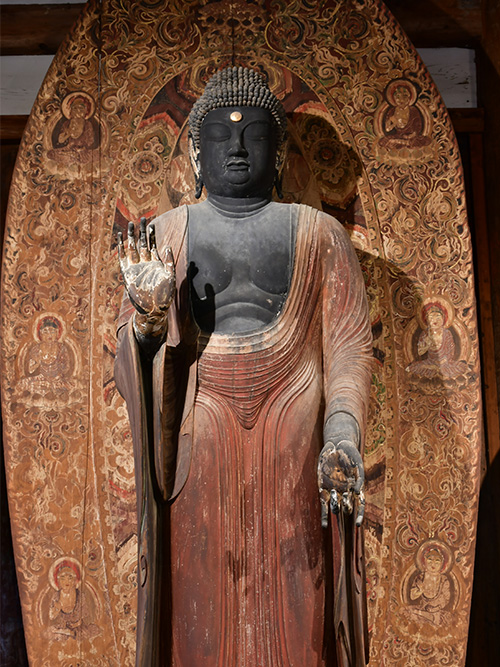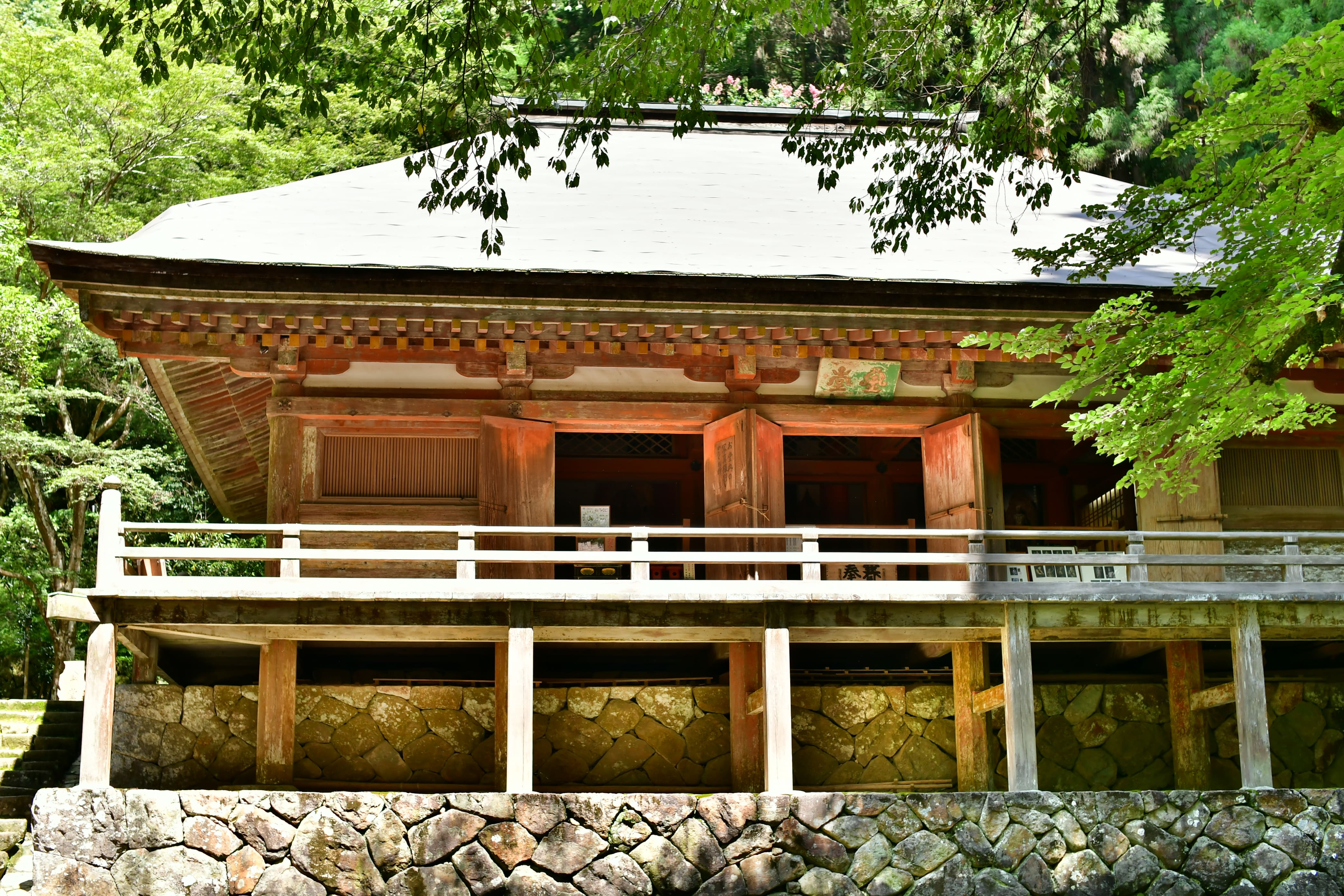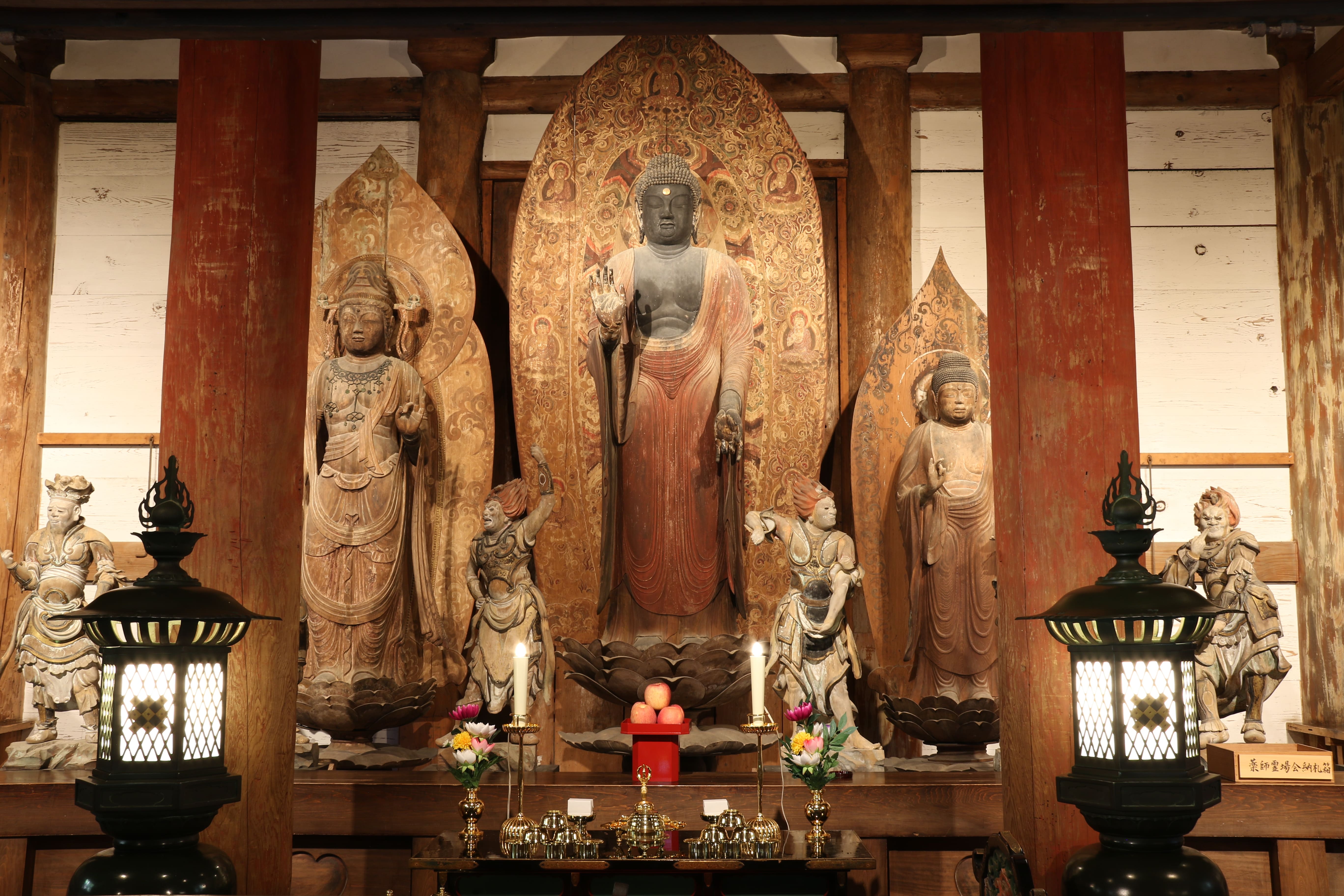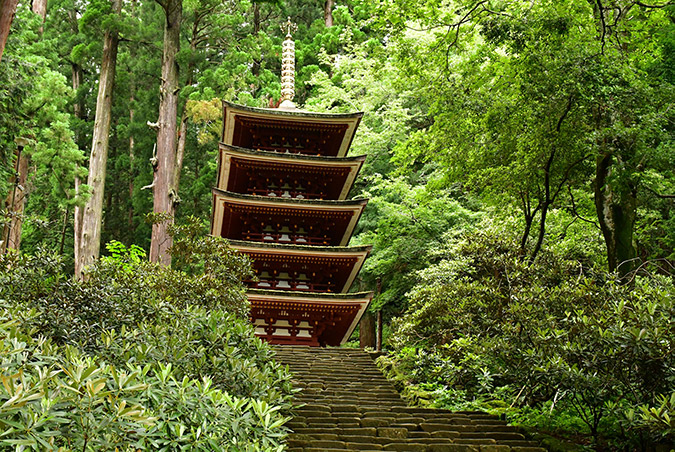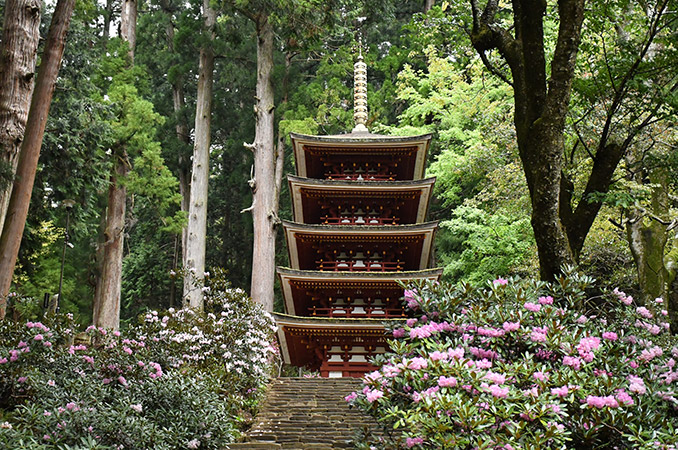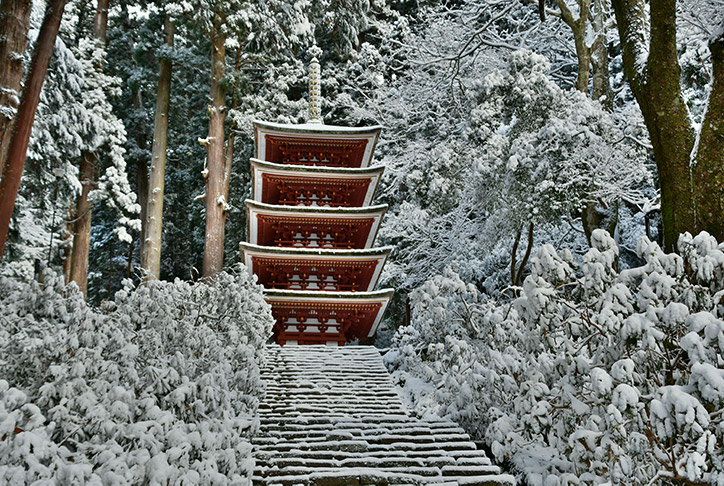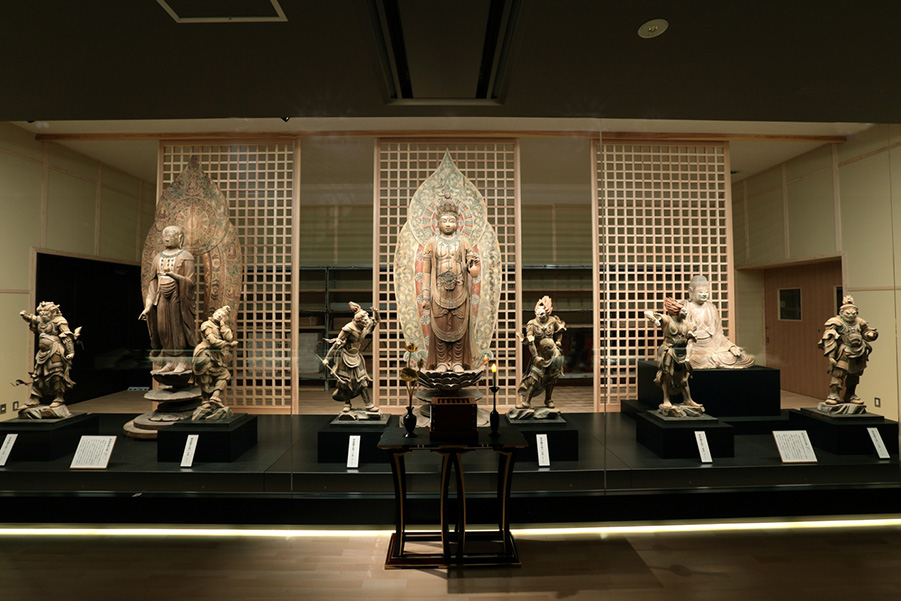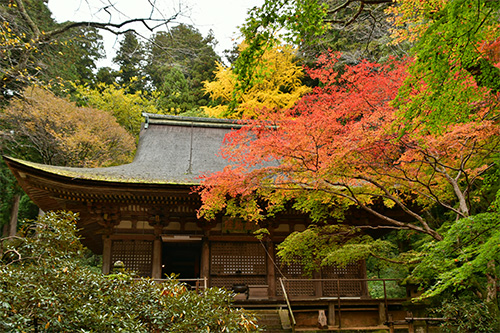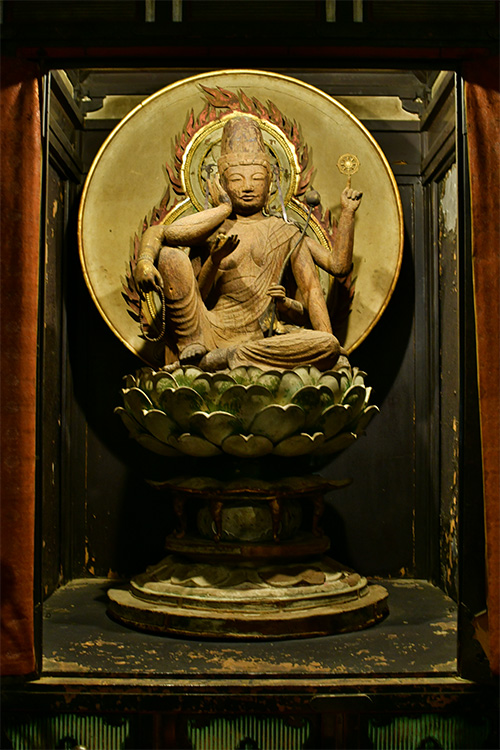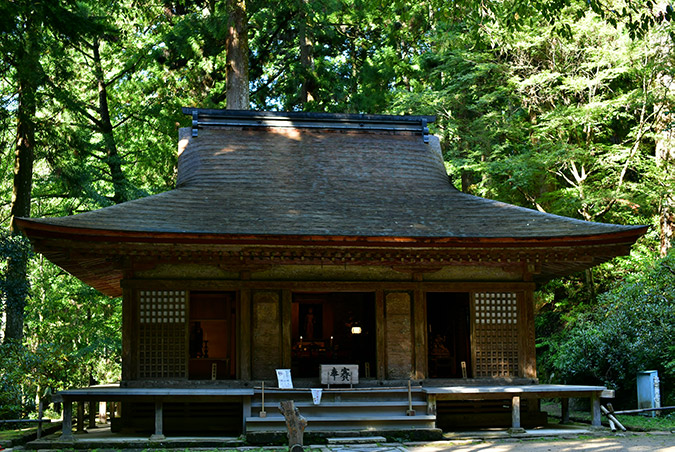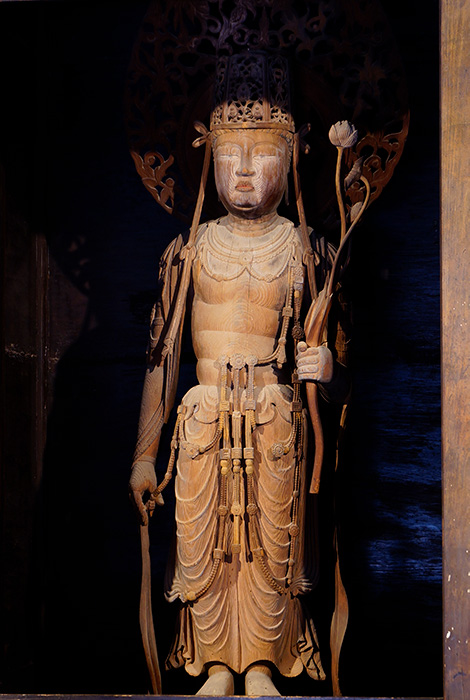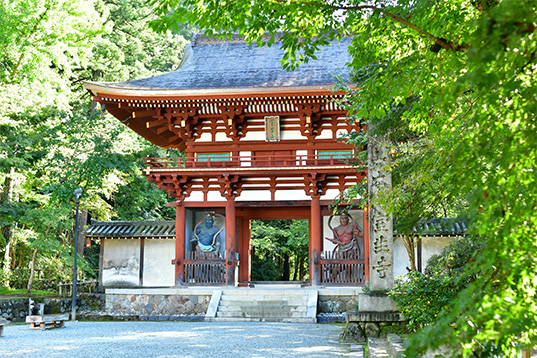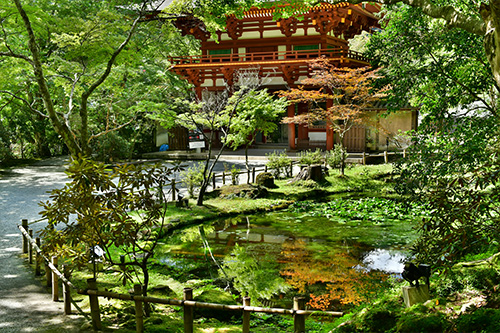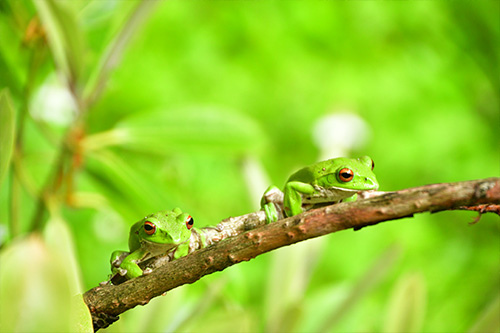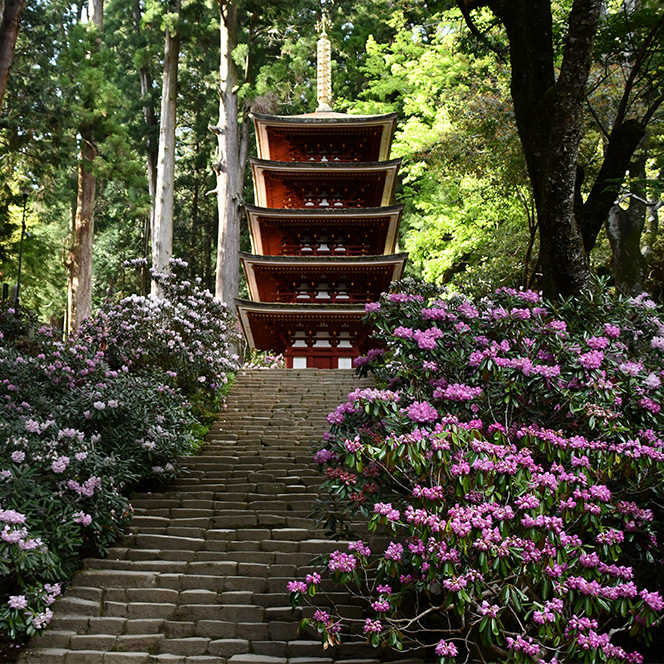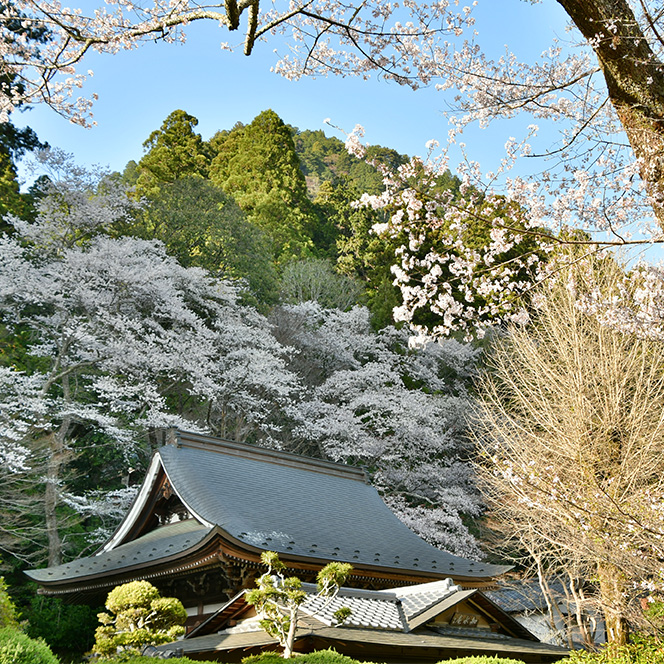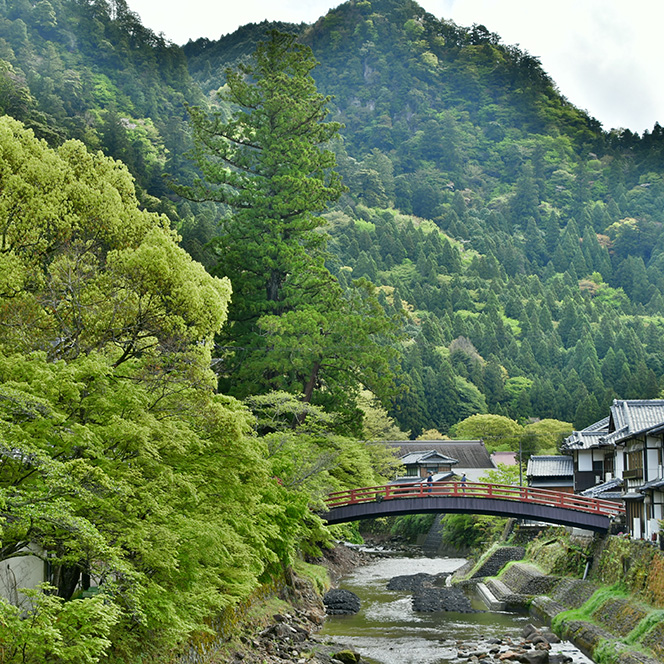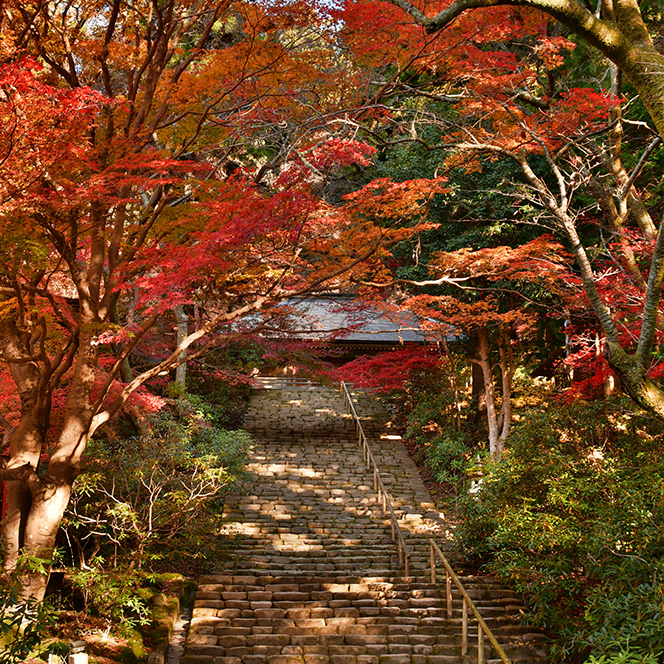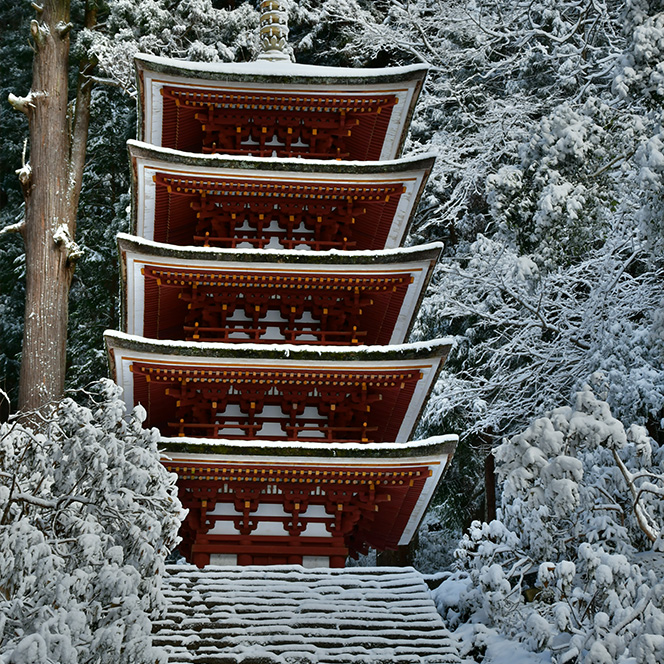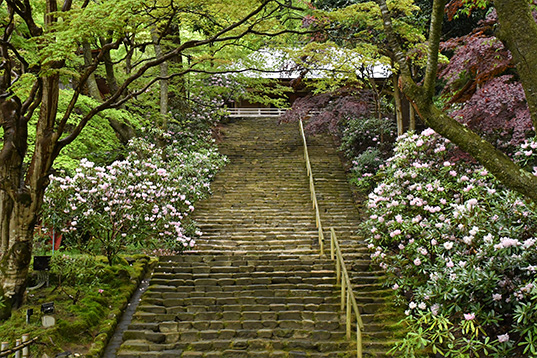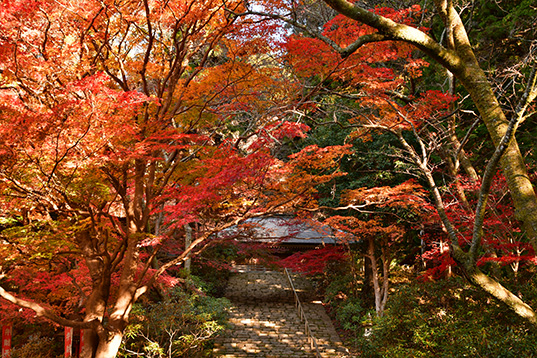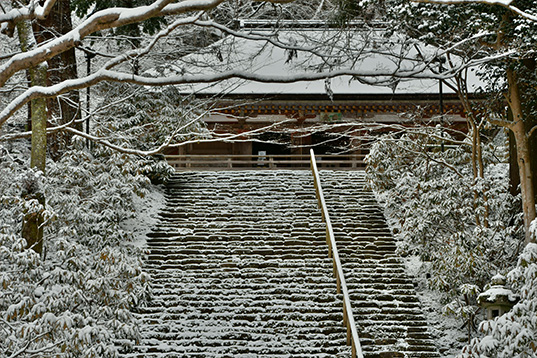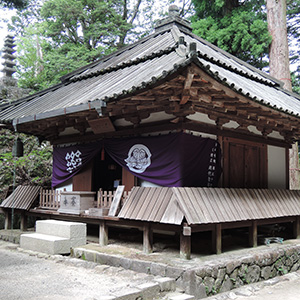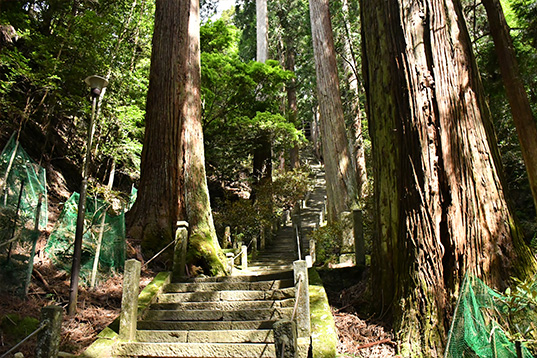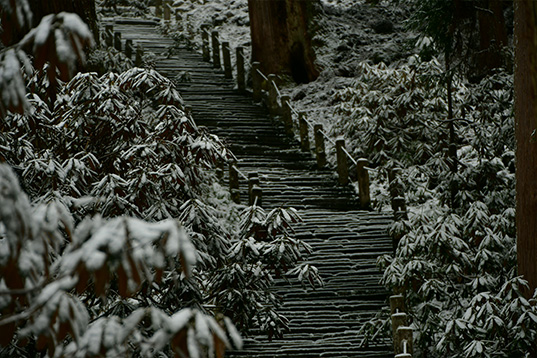Muroji Temple
The Buddha of Enlightenment
Muroji Temple has mercifully accepted women even at a time when many temples did not allow women to enter.
While Koyasan strictly forbade women, Muroji Temple is widely known as "Nyonin Koya," or "Mt. Koya for Women," and has long been revered as a sacred place of dragon god worship, deep in the mountains with clear streams flowing through it.
The main image of Shakyamuni Buddha in the main hall is made of wood.
The crest of his robe has the characteristics of the Honpa style pattern of the early Heian period.
The pattern which looks powerful, yet delicate and flowing in its own unique style is called Muroji-sama.
HIGHLIGHTS
-
National Treasure
Standing Statue of
Chuson Shaka Nyorai
Standing Statue of
Chuson Shaka NyoraiNational TreasureStanding Statue of Chuson Shaka Nyorai / National Treasure, Wooden, 234.8cm high, early Heian period
The beautiful statue in the main hall is Shakyamuni Buddha, the founder of Buddhism, who attained enlightenment and became the Buddha to save people forever.
It is believed that the Shakyamuni Buddha of Muroji Temple, with an expression of deep meditation, was originally an ancient statue of Yakushi Nyorai.
It was built in the early Heian period as well as the halo with its gorgeous design is also from the original period of its creation. -
National Treasure
Kon-do Hall


Kon-do HallNational Treasure
Kon-do Hall / National Treasure, early Heian period
Kon-do Hall houses the standing statue of Shaka Nyorai and Twelve Guardians.
The hall was built in the mid-9th century and is one of the oldest structures in Muroji Temple.
During the Edo period, Keishoin, the mother of the 5th Tokugawa Shogun Tsunayoshi, was deeply devoted to Buddhism and devoted herself to the repair and reconstruction of Muroji Temple's buildings including the large-scale renovation of the Kon-do Hall. -
National Treasure
Five-storied Pagoda

Five-storied PagodaNational Treasure
Five-storied pagoda / National Treasure, early Heian period
The five-story pagoda is the symbol of Muroji Temple.
At approximately 16 meters high, it is the smallest five-story pagoda built outdoors in Japan.
The pagoda's upper section doesn’t have a typical decoration style but a shape of water vase or a jewel.
There is no other example of this type of pagoda.
On September 22, 1998, the pagoda was severely damaged by a fallen tree caused by the strong winds of Typhoon No. 7 that hit the Kinki region, but as soon as news of this broke, a flood of support poured in, and restoration was completed in only about two years.

-
Homotsuden Hall

Homotsuden Hall
Homotsuden Hall
The Buddhist statues enshrined in the hall, including the ones designated as National Treasures and Important Cultural Properties, have withstood the changes in outside temperature and humidity for more than 1,000 years while undergoing repeated restorations.
However, global warming is affecting the environment of the mountain.
Considering the passing down of Buddhist statues to the next generation, it is necessary to improve the environment inside the hall, but because the hall itself is designated as a cultural property, no new work can be done to it.
In addition, it is difficult to protect the treasures from moisture and insects in the aging storage.
For this reason, the new Homotsuden Hall was constructed to protect and disperse cultural properties, and was completed in March 2020.
The Homotsuden Hall will pass the temple treasures on to the next generation including the Buddhist statues and other items that have been offered and prayed for in Muro.
[National Treasure] Standing Statue of Eleven-Headed Kannon (Early Heian period)
[National Treasure] Seated Statue of Shaka Nyorai (Early Heian period)
[Important Cultural Property] Standing Statue of Jizo Bosatsu (Early Heian period)
[Important Cultural Property] Standing Statues of Twelve Guardians (Kamakura period)
In the Homotsuden Hall, the guardians of Tiger, Rabbit, Dragon, Snake, Sheep and Rooster are enshrined. -
National Treasure
Main Hall (Kanjo-do Hall)
National Treasure /
Statue of Nyoirin Kannon Bosatsu
Main Hall (Kanjo-do Hall)National Treasure
Main Hall (Kanjo-do Hall) / National Treasure, Kamakura period
The hall was built for the esoteric Buddhist ceremony called Kanjo, an important ceremony of the Shingon sect.

Statue of Nyoirin Kannon BosatsuImportant Cultural Property
Statue of Nyoirin Kannon Bosatsu / Important Cultural Property, wood, height: 78.7cm, Heian period
This Nyoirin Kannon, with an expression of feminine tenderness, is one of the three greatest Nyoirin Kannon statues in Japan.
Holding a gem and a wheel-shaped treasure, she is believed to be beneficial for the fulfillment of various desires. -
Important Cultural Property
Miroku-do Hall /
Standing Statue of
Miroku Bosatsu
Miroku-do Hall Important Cultural Property
Miroku-do Hall / Important Cultural Property, Kamakura period
The hall was once used for prayers for rain and a good harvest.
During renovation work, a large number of small pagodas made of wood were found under the platform and on the ceiling.
Standing Statue of
Miroku Bosatsu Important Cultural PropertyStanding Statue of Miroku Bosatsu / Important Cultural Property, Wood, 94.4 cm high, late Nara period
It is the oldest Buddhist statue in the temple.
It is a representative example of the sculpture of this style, in which the body, the upper half of the lotus stand, the tips of the hands, the robe, and the details of the pavilion are all carved from a single piece of wood, and the coloring is reserved. -
Nio-mon Gate and
the Seasonal Beauty of
the Surrounding Area
Nio-mon Gate and the Seasonal Beauty of the Surrounding Area
The bright vermilion gate was reconstructed in 1965 and has a pair of red and blue Nio guardians.
After passing through the gate there is a small pond in which rare forest green treefrogs (Natural Monument) spawning on inhabited trees.


April & May:
3000 rhododendron trees burst into bloom
Spring:
Cherry blossoms
Summer:
Taiko-bashi Bridge surrounded by fresh green
Autumn:
Colored leaves
Winter:
tranquil snow view -
Yoroi-zaka Slope

Yoroi-zaka Slope
Walking up the Yoroi-zaka slope surrounded by fresh green andpale pink rhododendron will reach the Kon-do Hall.
Stone-paved floor looks like an armor thus the stairs are called “Yoroi-zaka” (the Armor Hill”).

-
Important Cultural Property
Mie-do Hall of
the Inner Sanctuary
Mie-do Hall of the Inner SanctuaryImportant Cultural Property
Mie-do Hall of the Inner Sanctuary / Important Cultural Property, Kamakura Period
After climbing 700 steps from the Nio-mon Gate, you will reach the Mie-do Hall. The Mie-do Hall dedicated to the image of Kobo Daishi that is open to public on the 21st of every month.


Cultural Assets
-
Muroji Temple Five-storied Pagoda
- Category
- National Treasure (building structure)
- Era
- Early Heian period (800)
- Outline
- The roof of the pagoda has a special structure called Hiwadabuki which uses cypress bark. This 16.1-meter pagoda is the smallest five-story pagoda standing in the open air and is also the oldest building in the Muroji Temple complex.
In September 1998, the pagoda was severely damaged by a fallen tree caused by the strong winds of Typhoon #7 that hit the Kinki region, however, it was restored very quickly in about two years.
-
Muroji Temple Kondo Hall
- Category
- National Treasure (building structure)
- Era
- Early Heian period (800)
- Outline
- Kondo Hall, together with the five-story pagoda, is said to have been built during the period when Muroji Temple was founded. It is thought to have been constructed in the early Heian period. The front part has hte kake-zukuri (erecting structures leaning against mountains or cliffs) is a Raido Hall (a place for public worship) which was added in the Edo period (1603-1868). Before the Raido was added, The building is the yosemune-zukuri style whose roof was made with the technique called Kokera-buki (a method of construction in which layers of wood shingles are layered on top of each other).
-
Muroji Temple Main Hall(Kanjodo)
- Category
- National Treasure (building structure)
- Era
- Early Kamakura period (1308)
- Outline
- It is a large hall built in the Irimoya-zukuri style (about 9-meter square). It consists of two different architectural styles: the Wayo style and the Daibutsu-yo style. The building was built in the early Kamakura period when techniques were at their height, therefore, techniques found here are skillfully incorporated in every detail.
-
Wooden Standing Shaka Nyorai (Shakyamuni Nyorai Buddha)
- Category
- National Treasure (sculpture)
- Era
- Early Heian period
- Outline
- This 234.8 cm high statue is the principal image of Kondo Hall. It is known that the statue was originally created as Yakushi Nyorai (the Buddha of Healing). The flowing crests on the vermilion robe are unique pattern called the Renpashiki, characterized by two smaller waves between the larger waves. This style is also known as the Muroji-yo pattern.
-
Wooden Standing Juichimen Kannon(Eleven-Headed Kannon <Ekadashamukha>)
- Category
- National Treasure (sculpture)
- Era
- Early Heian period
- Outline
- This 196.2cm high statue was made from a single Japanese torreya tree. This colored Buddhist statue is a remarkable example of skillful carving, even the incarnation of the Buddha above his head is clearly carved out. The beautiful base of the statue is called Eight-layered Lotus Flower Seat. Although one can see that some restoration works were added later, it is a good example of the carving style of the early Heian period.
-
Wooden Seated Shaka Nyorai (Shakyamuni Nyorai Buddha)
- Category
- National Treasure (sculpture)
- Era
- Heian period
- Outline
- This 106.3cm high statue was made from a single Japanese torreya tree. The sturdy, stable body and the tight yet calm facial expression are beautiful. The Hompa pattern (fluttering wave pattern), reminiscent of a clear stream in a canyon, looks clear and precise. Alternating the large folds and small folds represents the fluttering of waves which is called Hompa pattern (fluttering wave pattern).
-
Said to be the Taishakuten (Shakra) Mandala [Raigo Wall in the Kondo Hall], Colored Wood Board
- Category
- National Treasure (painting)
- Era
- Heian period
- Outline
- 351 cm high x 192 cm width. This colorful painting was painted on a space between four pillars of the wooden wall behind the Shumidan (dais for Buddhist images) in the Kondo Hall, using five vertical cypress boards that are aligned together. It is thought to have been painted around the middle of the 9th century. It is a valuable relic as a rare wall painting artifact.
-
Muroji Temple Miedo Hall
- Category
- Important Cultural Property (building structure)
- Era
- Kamakura period
- Outline
- Miedo Hall, also called Daishido Hall, is located in the inner sanctuary and enshrines a statue of Kobo Daishi Kukai. The double roof is thatched with wood boards and its stracture is called Hogyo style (tented roof). The metal decoration set at the top of the roof is an outstanding piece of craftsmanship. There are many Daishido halls throughout Japan, but this is one of the oldest.
-
Muroji Temple Mirokudo Hall
- Category
- Important Cultural Property (building structure)
- Era
- Kamakura period
- Outline
- The hall is located on the left (west) side of the garden in front of Kondo Hall. It is believed to have been built in the early Kamakura period (1185-1333). Originally facing south, it was changed to face east in the Muromachi period (1333-1573), and was renovated in the early Edo period (1603-1868).
-
Wooden Nyoirin Kannon Bosatsu(Bodhisattva Kannon <Avalokiteshvara>)
- Category
- Important Cultural Property (sculpture)
- Era
- Heian period
- Outline
- This is the main image of Muroji Temple. The statue is made of one wood piece of kaya (Japanese torreya). The head is straight and upright, and the upper part of the body is wide and thick, which is typical of the massive statues carved from one piece of wood from the Heian period.
-
Wooden Standing Miroku Bosatsu(Bodhisattva Miroku <Maitreya>)
- Category
- Important Cultural Property (sculpture)
- Era
- Heian period
- Outline
- This statue is the main image of Mirokudo Hall. The statue is 94.4 cm tall and made of one piece of kaya (Japanese torreya) wood. From the chest to the waist, the ornament of magnificent jewels and other woven ornaments are precisely carved. Generally, Buddhist statues carved from sandalwood or other aromatic wood are called “danzo”, however, since sandalwood is not available in Japan, fine-grained, high-quality wood is often used instead for this type of carving.
-
Wooden Standing Yakushi Nyorai (Bodhisattva Yakushi) [Said to be made by Kukai]
Wooden Standing Monju Bosatsu (Bodhisattva Monju) [Said to be made by Kukai]- Category
- Important Cultural Property (sculpture)
- Era
- Heian period
- Outline
- Two Buddhist statues are placed on either side of the main image in Kondo Hall. Both statues are made of a single piece of wood from around the 10th century. Since their size and style are different, they are thought to have been moved from other temples respectively in the mid-Edo period.
-
Wooden Standing Jizo Bosatsu (Bodhisattva Jizo <Ksitigarbha>)
- Category
- Important Cultural Property (sculpture)
- Era
- Early Heian period
- Outline
- A 160.0cm high Buddha statue. It is a colorful statue made of a single piece of cypress wood. The itakohai (the wooden board behind the statue which embodies and depicts light emitted from the Buddha) does not match the size of the statue, therefore, it is thought that this itakohai did not originally belong to this image. It is said that the Buddhist image that fits this itakohai is the Jizo Bosatsu enshrined at Ansanji Temple, located about 9 km away from Muroji Temple.
-
Wooden Standing Twelve Guardians
- Category
- Important Cultural Property (sculpture)
- Era
- Kamakura period
- Outline
- A group of wooden, colored, statues of around 100 cm high. The Twelve Guardians are the retainers of Yakushi Nyorai which is the Buddha of medicine and healing. Each of these statues has one of the twelve animals of the Chinese zodiac on their heads. The exaggerated and free expression is characteristic of the mid Kamakura period and is representative of this period. The Kondo Hall enshrines the guardians of Mouse, Ox, Horse, Monkey, Dog and Boar. In the Homotsuden Hall, the guardians of Tiger, Rabbit, Dragon, Snake, Sheep and Rooster are enshrined.
GUIDE / ACCESS
| Opening Hours: | Open:April-November: 8:30 a.m.-5:00 p.m., December-March: 9:00 a.m.-4:30 p.m. *Homotsuden Hall: 9:00 a.m.-4:30 p.m. *December 1st to March 31st: 9:30 a.m.-3:30 p.m., last entry: 3:00 p.m. |
|---|---|
| Address: | 78 Muro, Uda City, Nara |
| Access: | From Kintetsu Muroguchi-Ono Station, take a bus to the "Muroji" stop. |
